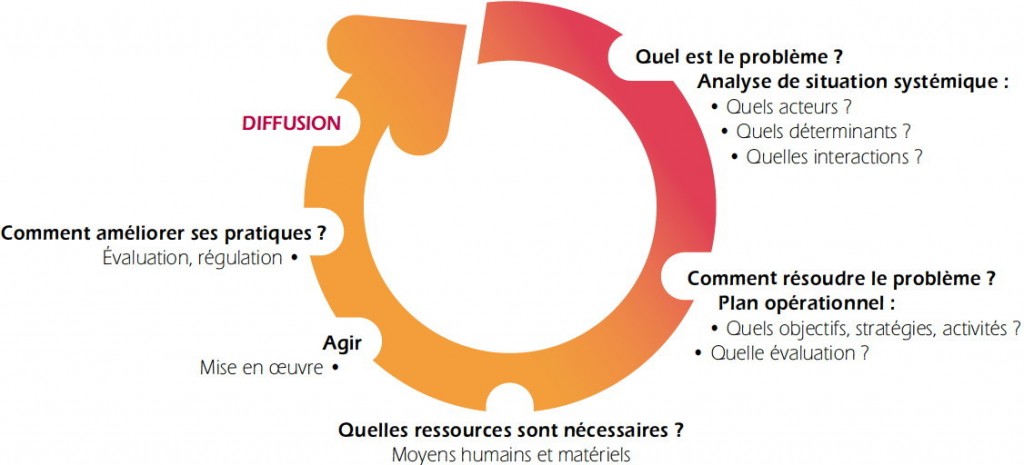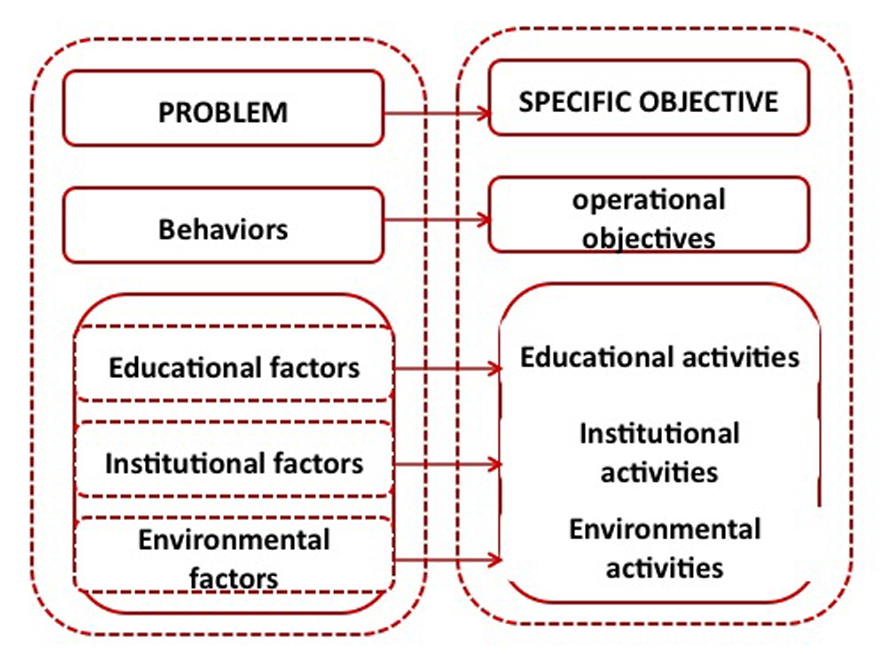1. Systemic, intersectoral and participatory approach
The CS-FGM are based on a project management cycle, which is a planning method per program, i.e. ‘a rational and logical method for developing and implementing activities and health services by mobilising the appropriate resources in an organised manner’ 10. This method uses a logical framework and defines the logical phases of a program (see fig. 1): situational analysis, development of an action plan, budgeting, and evaluation.

Figure 1: Project cycle management
The planning model used and adapted(1) for the subject is the PRECEDE-PROCEED model developed by Green and Kreuter(2) (Fig. 1). It allows for problem analysis (PRECEDE phase(3)) taking into account its multifactorial nature and by classifying the determinants that contribute to the problem into different categories. These categories are behaviour, education, environment, politics and administration, and socio-demographic variables.
The planning, which is based on situational analysis and the same systemic approach (PROCEED phase(4)), consists of setting the objectives and identifying relevant activities to act upon behaviour, environment, and social factors. Therefore, these activities are necessarily multidimensional and multisectoral.
Both the situational analysis phase and the planning phase require the participation of representative stakeholders, who are called upon to define the issue, the objectives and the activities by consensus.
2. Logical steps
1. The situational analysis phase involves several logical steps:
For the target group involved, an epidemiological and social diagnosis is performed by reviewing the scientific data and the available observations from the field.
The problem is defined by consensus and by summarising the most pertinent variables of the diagnosis.
After the problem has been defined, the contributing actors and their behaviours are identified and listed in the behavioural diagnosis. This concerns the target group (and possible subcategories of this target group), but also actors who interact directly or indirectly with this target audience and/or the problem.
After the actors and their behaviours have been identified, the factors (determinants) linked to these behaviours are investigated and classified in the appropriate diagnosis.
The educational and motivational factors, either ‘predisposing’ (representations, knowledge, attitudes, beliefs, intentions), ‘enabling’ (knowhow, abilities, skills) or ‘enforcing’ (peer influence, reward mechanisms), are listed in the educational and motivational diagnosis.
Environmental factors (physical and social) are listed in the environmental diagnosis, and
institutional factors (policy and administrative) in the institutional diagnosis.
Socio-demographic factors (age, educational level, socio-economic status, sex, etc.) and biological factors (any biological characteristic with an impact on the issue or the behaviours) are also listed in the corresponding diagnosis. In view of the interdependence of factors playing a role in concrete situations, the diagnosis of the situational analysis is studied and analysed in close interconnection, as illustrated in figure 2.

Figure 2: Diagnosis of the situational analysis
2. The planning phase deals with the creation of a logical framework (or operating plan) which defines the intervention strategies and the activities, based on the situational analysis.
A specific objective with regard to the problem is defined for the target group. This specific objective constitutes the global framework and the overall, sustainable objective of the operating plan. The description of the behaviours of the actors makes it possible to set operational objectives. These objectives address one or more problems identified in the behavioural diagnosis and will be translated into concrete actions.
The educational, environmental and institutional activities are defined on the basis of the corresponding factors which they aim to change in order to reach the operational objectives. The activities are the most concrete part of the operating plan since they are bound to be implemented with appropriate resources.
In the planning phase, criteria and indicators for the evaluation of objectives and activities must be defined, as well as the available sources of information for collecting evaluation data. This phase will be the subject of a number of focus groups and an upcoming publication.

Figure 3: Transition from the situational analysis phase to the planning phase
The situational analysis forms the foundation of the operationalisation work, as shown in figure 3.
This way, a consistent analysis of the behaviours and their determinants results in an equally consistent system of operational objectives and activities.
Starting from a situational analysis as exact and exhaustive as possible, this approach makes it possible to identify a wide range of actions to be implemented, but also to outline the limits of these actions, since not all identified determinants can be changed.
1 PARENT F. (March 2006), Déterminants éducationnels et facteurs favorables à une meilleure adéquation entre formation et compétences attendues des professionnels de la santé dans les organisations de santé en Afrique. Étude sur la gestion et le développement des ressources humaines en santé, PhD dissertation, Brussels, École de Santé Publique of the ULB. ↑ Back
2 GREEN L.W. & KREUTER M.W. (2005), Health Program Planning, An Educational and Ecological Approach. 4th Ed. Mc Graw Hill, http://www.lgreen.net ↑ Back
3 The acronym PRECEDE stands for ‘Predisposing, Reinforcing and Enabling Constructs in Educational/Environment Diagnosis and Evaluation’. ↑ Back
4 The acronym PROCEED stands for ‘Policy, Regulatory and Organisational Constructs in Educational and Environmental Development’. ↑ Back
